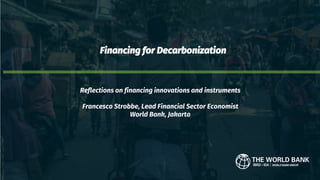
World Bank_Financing for Decarbonization_OECD SM Dec 6 2022.pdf
- 1. Financing for Decarbonization Reflections on financing innovations and instruments Francesco Strobbe, Lead Financial Sector Economist World Bank, Jakarta
- 2. The Challenge Transforming Indonesia’s economy to achieve net-zero by 2060 cannot be achieved without greening the private sector. Significant more progress is required in expanding green finance at a pace commensurate with investment needs. However, progress has been lacking due to two binding constraints: Lack of investment in green technology; From a firm perspective marginal benefits of adopting green technology are too small 1 Lack of green finance; Indonesia’s financial sector is too shallow, and financing is too short-term to serve green sectors. 2 These binding constraints can be addressed by: (i) lowering the cost of acquiring green technologies (ii) mobilizing long-term, private green financing and opening-up green markets.
- 3. Binding Constraint 1: Lack of investment in green technology In the current operating environment, there is little incentive to invest in energy efficiency –from a firm perspective- as the marginal benefits are too small An example: an improvement in energy efficiency requires significant new investment in better capital… … but this investment would only slightly improve operating profit 66.6 63.5 63.3 45.2 48.3 48.5 Baseline Simulation 1 Simulation 2 Baseline Simulation 1 Simulation 2 Total Production Cost (in Billion IDR) Profit (in Billion IDR) 31.5 116.1 250.5 Baseline Simulation 1 Simulation 2 Capital (in Billion IDR) Low-efficient firms (i.e., below the median within their sector of activity) can improve their efficiency to two frontier target. Target 1: Efficiency level of median firms within the three-digit ISIC (simulation 1). Target 2: Efficiency level to the top 20 percent of the most efficient firm in the same three-digit ISIC (simulation 2) Source: World Bank analysis using Indonesia Manufacturing Statistics 2015
- 4. Binding Constraint 2: Lack of green finance However, green finance markets in Indonesia have not reached the scale required to meet the needs of Indonesia’s climate goals. Over the past seven years, only US$ 13.2 billion of private, green finance has been mobilized as the financial sector is: Very shallow Indonesia’s green bonds currently make up 1.5% of total bonds issued (or 0.6 percent of GDP), much lower than most G20 peers, with limited private sector involvement (<30%). Private sector credit to GDP in Indonesia stands at only 38% (EAP average of 172%) with green finance accounting for only 2% of total banking loans, due to a variety of factors including lenders’ risk aversion , lack of information, absence of clear, consistent definitions on green activities and lack of expertise. PE/VC is deals in Indonesia reached a value of US$ 6.37 billion in 2021 but green investments are a small fraction of the total. (i) Biased towards short-term financing (ii) Banks typically provide loans that match their deposit timeframe, which may not be suitable for investments in green technologies that require longer-term financing (5+ years) Amongst ASEAN countries, Indonesia requires the largest volume of green finance, an estimated US$ 247 bn (~21% of Indonesia’s 2021 GDP) by 2030 to meet its NDC of reducing greenhouse gas emissions by 29%. Debt Equity Debt Equity PE/VC funds in Indonesia tend to have short investment timeframes (3 years), while green investments often require more patient capital.
- 5. Green finance markets could help close the climate funding gap, but they remain small, especially in developing countries 5 Green / sustainable finance markets are growing globally However, these markets remain small in most countries Sustainable debt annual issuance Source: BloombergNEF, Bloomberg LP Source: Climate Bond Initiative Green bond issuance in 2021
- 6. Green finance markets in Indonesia have not reached the scale required to meet the needs of climate goals 0% 2% 4% 6% 8% 10% 12% 14% 2022 2021 2020 2008-2019 ▪ According to the National Long Term Development Plan (2005-2025), USD 186 billion (~18% of Indonesia’s GDP) in private finance is needed by 2030 to support the country’s GHG emission reduction target ▪ Green or sustainable finance markets (e.g., labelled bonds) could provide an avenue to mobilize private finance for climate action. However, these markets remain small in Indonesia. Key challenges include: ▪ Lack of information around green projects ▪ Lack of consistent definition, reporting, disclosures and data analytics on green activities ▪ Lack of expertise and internal resources for capacity building 0% 20% 40% 60% 80% 100% India Indonesia Brazil Turkey Mexico Sustainability-linked bond Sustainability bond Social bond Green instrument Labelled bond issuance in Indonesia compared to G20 peers Share of instrument types relative to total labelled bond issued
- 7. Some initial ideas • Develop more detailed climate disclosure requirements for banks, non-bank financial institutions and listed companies. • Integrate the green taxonomy into regulation/guidance (e.g., for labelled bonds) and disclosure/reporting frameworks. Disclosure & Reporting Green Finance • Consider launching a Sovereign Green Fund to mobilize other investors (primarily international), underwriting the issuances of green instruments. • Accelerate municipal green bond issuance by simplifying issuance requirement and procedures and enhancing issuer capacity to process and handle liabilities. • Explore blended finance options to catalyze private finance for climate action.
- 8. Thanks!
